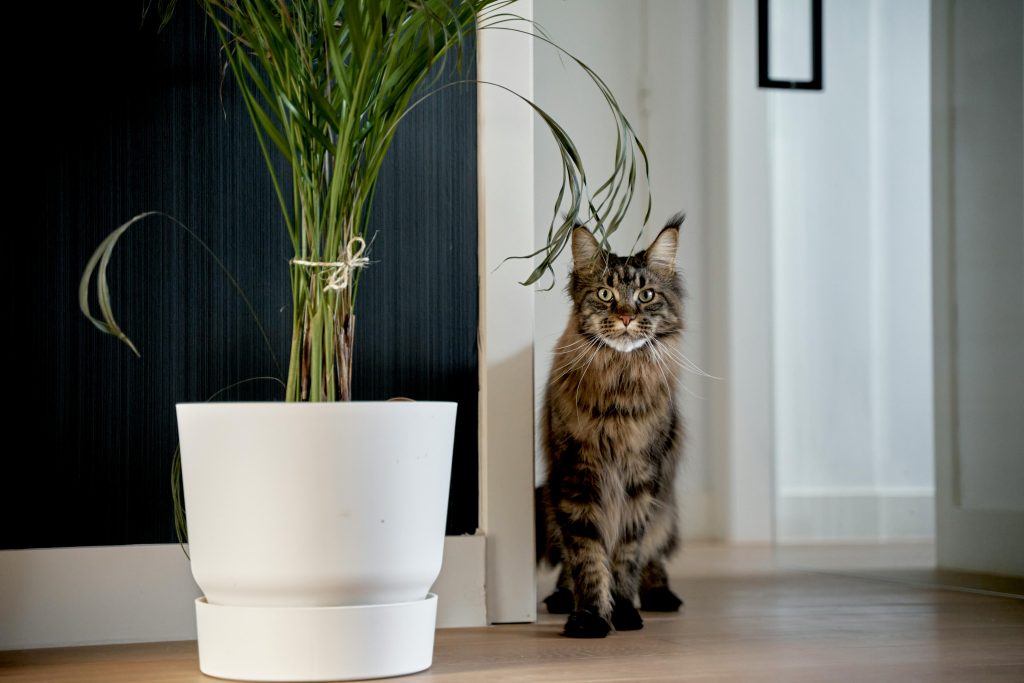Cats are interesting creatures, each with unique personalities that range across the spectrum, but with similar quirky behaviors that link them together. From zooming around the house at 3 a.m. to kneading your lap with their paws, these antics can leave us equally confused and entertained. Let’s delve deep into the fascinating world of weird cat behaviors, unraveling the mysteries behind their actions and providing insight into what they might be trying to communicate.
Pouncing and Chasing
One moment your cat is lounging peacefully, and the next, they’re pouncing on an invisible prey or chasing after a toy with wild abandon. Pouncing and chasing are instinctual behaviors rooted in your cat’s hunting ancestry and are important parts of your cat’s daily enrichment. Even indoor cats retain these predatory instincts and engage in playful hunting behaviors to satisfy their natural urges. Encouraging these behaviors include offering toys based on your cat’s prey preference, with most cats falling into preferred categories of mice, birds, bugs, or a combination! Make sure to rotate your cat’s toys as well to ensure nuance and variety.
Kneading
Your cat rhythmically presses and kneads their paws against soft surfaces, like your lap or a cozy blanket. Kneading, also affectionately called muffin or biscuit making, is a behavior kittens exhibit while nursing, stimulating milk flow from their mother. Adult cats often continue this behavior as a sign of comfort, relaxation, or contentment. It’s a throwback to their kittenhood, indicating they feel safe and secure in their environment.
Head-Butting (Bunting)
Your cat affectionately presses their head against your hand, face, or other objects. Head-butting, or bunting, is a form of communication and bonding for cats. By rubbing their scent glands located on their head and face on you or objects, they’re marking you as part of their territory and expressing affection.
Zoomies
Suddenly, your cat goes into full sprint mode, tearing through the house at breakneck speed, often in seemingly random directions. Zoomies, also known as frenetic random activity periods (FRAPs), are bursts of energy that cats release through rapid, high-speed running. They can be triggered by pent-up energy, excitement, or simply the joy of movement.
Bringing “Gifts”
Your cat proudly presents you with “gifts” in various forms. This may be their favorite toy, or if you’re really lucky the whole or partial remains of their dead or injured prey, such as mice, birds, or insects. While it may seem gruesome to us, bringing “gifts” is a natural behavior for cats and a display of their hunting prowess. They’re sharing their spoils with you, their beloved human, as a gesture of friendship or an attempt to teach you how to hunt.
Catnip Sensitivity
Your cat rolls around in ecstasy, rubs against, or chews on catnip-infused toys, exhibiting seemingly euphoric behavior. Catnip contains a compound called nepetalactone, which triggers a response in cats’ olfactory receptors, leading to behavioral changes like rolling, rubbing, or increased playfulness. Not all cats are affected by catnip, as sensitivity is genetically determined and can vary between individuals.
Sleeping in Weird Places
Your cat eschews their plush bed in favor of sleeping in the most bizarre and unconventional spots, like cardboard boxes, sinks, or laundry baskets. Cats are creatures of comfort and seek out warm, cozy, and secure spots for rest. Weird sleeping locations may offer a combination of these qualities, along with a sense of privacy and seclusion.
Tail Twitching
Your cat’s tail twitches or flicks back and forth rapidly, often accompanied by other body language cues. Tail twitching is a form of feline communication and can convey a range of emotions, from excitement or anticipation to irritation or aggression. Understanding the remainder of your cat’s body language and context is key to interpreting the meaning behind their tail movements.
“Burying” Food
Your cat scratches at the floor or around their food bowl, as if trying to bury their food. Burying food is a natural instinct for cats, stemming from their wild ancestors’ behavior of covering up leftover prey to hide it from scavengers. Your cat may be signaling that they’re finished eating or attempting to hide the food for later consumption.
Vocalization Variations
Your cat meows, chirps, trills, yowls, or makes other vocalizations, each with its own distinct meaning. Cats communicate through a diverse range of vocalizations, each serving a specific purpose. Meows may indicate hunger or a desire for attention, while chirps and trills are often used as greetings or expressions of excitement. Yowling may signal distress or discomfort, requiring further investigation.
While cats may seem enigmatic at times, their behaviors often have fascinating explanations rooted in their evolutionary history, instincts, and communication needs. By understanding and interpreting these weird cat behaviors, you can deepen your bond with your feline friend, enrich their environment, and ensure their physical and emotional well-being. Remember, every cat is unique, so observe your pet closely and embrace their individual quirks with curiosity and affection.

